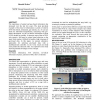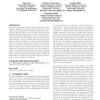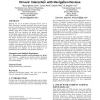AUTOMOTIVEUI
2009
ACM
14 years 7 months ago
2009
ACM
Nowadays, personal navigation devices (PNDs) that provide GPSbased directions are widespread in vehicles. These devices typically display the real-time location of the vehicle on ...
AUTOMOTIVEUI
2009
ACM
14 years 7 months ago
2009
ACM
The importance of spatial and geo-based information has increased over the last few years. The most prevalent example of this kind of information is points of interest (POI) like ...
AUTOMOTIVEUI
2009
ACM
14 years 7 months ago
2009
ACM
There has been an increasing interest for in-vehicle interfaces that make use of haptic information. A simulator study was conducted to investigate whether haptic information can ...
AUTOMOTIVEUI
2009
ACM
14 years 7 months ago
2009
ACM
Older drivers represent the fastest growing segment of the road user population. Cognitive and physiological capabilities diminishes with ages. The design of future in-vehicle int...
AUTOMOTIVEUI
2009
ACM
14 years 7 months ago
2009
ACM
The increasing traffic volume confronts the road user with a challenging task. The high number of traffic deaths might not be reducible with passive safety alone. However systems ...
AUTOMOTIVEUI
2009
ACM
14 years 9 months ago
2009
ACM
We present an experimental study on the effectiveness of five modality variants (speech, text-only, icon-only, two combinations of text and icons) for presenting local danger wa...
AUTOMOTIVEUI
2009
ACM
14 years 9 months ago
2009
ACM
In this paper, we outline a system that supports the communication between passengers by transmitting speech (and maybe also video) of the communication partners back and forth. A...
AUTOMOTIVEUI
2009
ACM
14 years 9 months ago
2009
ACM
Over the last 100 years it has become much easier to operate a car. However in recent years the number of functions a user can control while driving has greatly increased. Infotai...
AUTOMOTIVEUI
2009
ACM
14 years 9 months ago
2009
ACM
Recently, the use of in-vehicle navigation devices, such as PNDs (Personal or Portable Navigation Devices) has become pervasive, and the device functions have been rapidly expande...
AUTOMOTIVEUI
2009
ACM
14 years 9 months ago
2009
ACM
In this paper, we present a concept for an open vehicular data interface and describe it’s components and architecture. We discuss the enabled applications in the context of adv...



